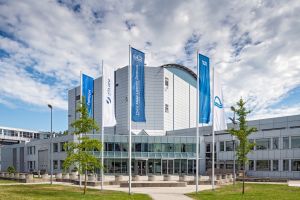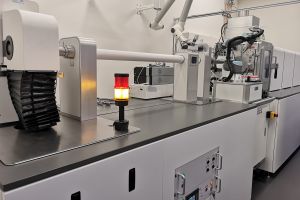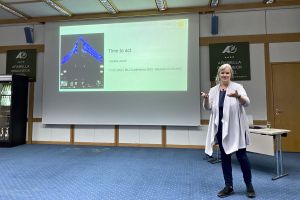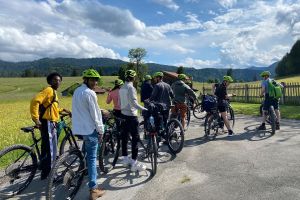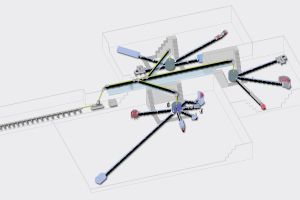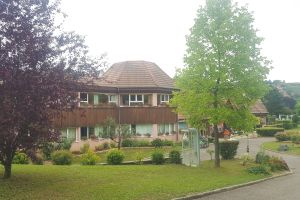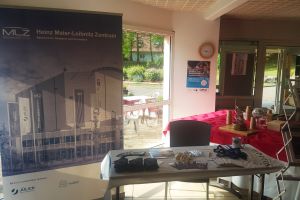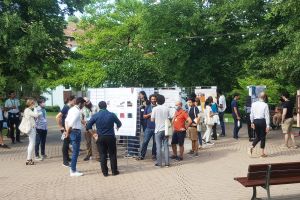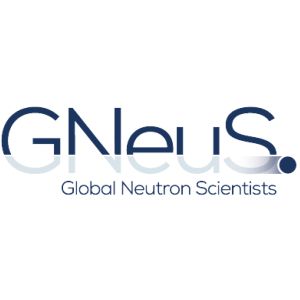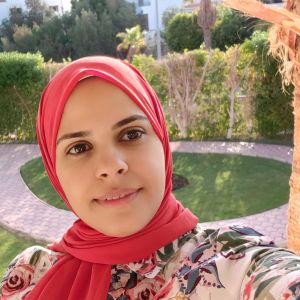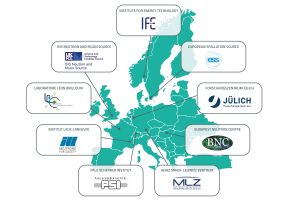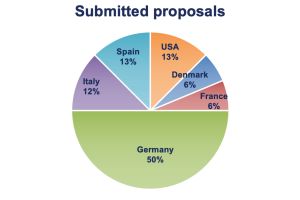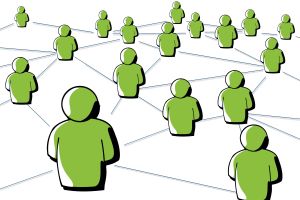MLZ is a cooperation between:
 > Technische Universität München
> Technische Universität München > Helmholtz-Zentrum Hereon
> Helmholtz-Zentrum Hereon
 > Forschungszentrum Jülich
> Forschungszentrum Jülich
MLZ is a member of:
 > LENS
> LENS > ERF-AISBL
> ERF-AISBL
MLZ on social media:

MLZ (eng)
Lichtenbergstr.1
85748 Garching
Newsletter II/2022
Jump directly to the chapters! (and don't forget to enlarge the pictures by clicking them!)
» Editorial» Instruments & labs» Events» People» UsersEditorial
Looking forward to neutron experiments
Providing high flux and brilliant neutron beams to our dedicated suite of instruments is our utmost mission at the MLZ.
Having passed the Corona crisis and the defect of the cold source last year, we recognized a water leakage near the central channel in January. The replacement, unfortunately, makes it very unlikely that we will be back in operation this year. This overall long shut down period had and will have a significant impact on the scientific plans we all have. All mitigation measures we could imagine are in place, however, the loss of beam time at our instruments hurts us all a lot.
In the meantime, we have put significant effort into upgrading and improving our instruments. We are looking forward to new and exciting experiments next year. Having that wish and the close involvement of our users in the planning of the restart in mind, we would like to invite you heartily to join us at our annual User Meeting on December 8th-9th. We are confident that it will be possible to meet in person at the Mariott Hotel Munich. You might remember this location from our last user meeting in person in 2019. This User Meeting will be of particular importance for us as we would like to discuss future access modes as well as further instrument developments for our envisaged instrument upgrade program MORIS.
Prof. Dr. Martin Müller (GEMS, Helmholtz-Zentrum Hereon, MLZ Director / Spokesperson)
Prof. Dr. Peter Müller-Buschbaum (FRM II, TU München, MLZ Director)
Prof. Dr. Stefan Förster (JCNS, Forschungszentrum Jülich GmbH)
Instruments & labs
» KWS-X: The new SAXS/WAXS Laboratory Beamline» Neutron coating development applied to non-depolarizing Cu/Ti supermirrors
» Welcome to the MatSciLab!
KWS-X: The new SAXS/WAXS Laboratory Beamline
The new customized SAXS/WAXS instrument from XENOCS has been installed in the JCNS X-ray laboratory since the end of 2021.
As a young member of our small-angle scattering instruments using X-ray as the beam, the new instrument is equipped with a high flux metal-jet source and a moveable Eiger 2R4M SAXS detector. With an additional 4-axis motorized WAXS detector and Bonse-Hart USAXS, the scattering vector q can cover a wide area from 0.0002 to 7 Å-1. Compared to other instruments, it also comprises a large sample environment station that can be used with ambient pressure conditions. Many sample environmental accessories make it possible to perform experiments at temperatures from -150 °C to 1000 °C, under shear, tensile, etc.
The instrument is under commissioning and is expected to operate in Autumn 2022.
Baohu Wu (JCNS)
Neutron coating development applied to non-depolarizing Cu/Ti supermirrors
In the last two years, the Neutron Optics Group of FRM II has successfully sputtered non-depolarizing m=2 Cu/Ti supermirrors, which had been prepared with a standard DC magnetron sputtering facility. Control on the roughness growth and interdiffusion allowed us to get a very good maximum angle of total reflection (ca. 0.21°/λ) and polarized neutron reflectivity above 90%, as measured at the instrument GINA, located at BNC in Budapest. No difference between R+ and R– components was found within the statistical error bars (fig. 1). By using R+ and R– we were able to calculate the Spin Asymmetry (SA) of the sample defined as SA = (R+ – R–)/(R+ + R–) as shown in fig. 2.
Checking the magnetic behavior
The magnetic behavior of the Cu/Ti coating was checked using SQUID measurements at the WMI in Garching to be slightly ferromagnetic with a magnetic moment of 10-3 Bohr-magneton/atom (fig. 3). For comparison, Ni/Ti and Ni(Mo)/Ti supermirrors were also measured, finding magnetizations of 0.55 Bohr-magneton/atom for Ni and 0.11 Bohr-magneton/atom for Ni(Mo), in agreement with data found in literature.
Simulation programs help
By knowing the structure of the sample, the simulation programs GenX and SimulReflec were used to distribute the magnetization measured by SQUID along the whole supermirror structure to check which would be the theoretical SA delivered by such a model and whether this could be compatible with the one measured experimentally. The result of such simulations, shown in fig. 4 denotes, besides some discrepancies, the compatibility of the theoretical model with the experimental SA result. Moreover, GenX and SimulReflec were also used to calculate the theoretical Spin Flip Reflectivity (i.e. depolarization) that this magnetization would deliver (fig. 5), finding a maximum value of a few times 10-6.
Jose Manuel Gomez Guzman (FRM II)
Find all figures explained in the gallery!
R+ and R– reflectivity measurements were performed by the whole GINA team (László Bottyán, Tamas Veres, Daniel Merkel and Szilárd Sajti) at BNC in Budapest (Hungary).
SQUID measurements were performed by Matthias Opel from the Walter Meissner Institute in Garching.
Welcome to the MatSciLab!
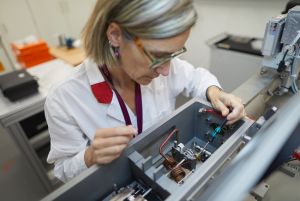
Cecilia Solis is setting up the dilatometer for an off-the-beam experiment in the lab. © Bernhard Ludewig, FRM II / TUM
The Materials Science Laboratory (in short MatSciLab) provides scientists with techniques for the analysis and preparation of samples for subsequent neutron scattering experiments. It offers a range of tools for sample preparation and basic characterization techniques such as micro-hardness measurements and optical microscopy. In addition, the lab houses more sophisticated equipment!
There is a state-of-the-art environmental scanning electron microscope (jointly operated by Helmholtz-Zentrum Hereon and Forschungszentrum Jülich GmbH). With its multiple detector system, this instrument enables the detailed characterization of morphology, topography, and composition of a wide variety of surfaces over length scales ranging from nanometer to macroscopic dimensions.
Additionally, you find a quenching deformation dilatometer: with this set-up, the mechanical properties of materials can be investigated by applying compression or tension forces up to 20/8kN respectively. Measurements can be performed at temperatures ranging from room conditions to 1500°C. Samples can be submitted to rapid heating (up to 4000°C/min) and cooling (up to 2500°C/min). The dilatometer can be used in the lab as well as can be installed on beamlines (at the moment SANS-1 and StressSpec).
And last but not least, we offer a high-precision 3D laser scanner: this instrument can be used to obtain a volume rendering of complex objects to prepare measurements at the neutron instruments.
Jean-Francois Moulin (hereon)
Events
» Neutrons for Mobility» HBS Instrumentation Workshop
» MLZ at Colloque Louis Néel
Neutrons for Mobility
After a period dominated by virtual meetings, this topical conference gave us back the pleasure of discussions in person. Thus, about 50 participants gathered at Lenggries from May 31st-June 03rd for this year’s MLZ conference “Neutrons for Mobility”.
In her talk “Time to Act”, Daniela Jacob, a leading author of the IPCC, provided a frightening overview of the consequences of not drastically reducing our CO2 emissions. Her message though was not one of desperation, she summoned our community to work on providing those technologies essential to overcome this formidable challenge.
In 27 talks, mobility-related fields ranging from high-performance alloys to innovative batteries, through porous membranes were addressed. Neutron methods were the common ingredient in this multidisciplinary meeting.
It was not only work! The nice location in Lenggries in the Bavarian Alps offered many options for half a day break. Whether they had gone for an e-bike ride, a hike, or a visit to a historic hydropower station, the 50 participants met in the evening to get a bite of the local gastronomy while sharing new ideas.
Jean-Francois Moulin (hereon)
Find more pictures in the gallery!
HBS Instrumentation Workshop
High current accelerator-based neutron sources (HiCANS) offer a novel option to provide neutrons for science and industry. The project of a High Brilliance Neutron Source (HBS) at the Forschungszentrum Jülich GmbH explores the possibilities and technical feasibility of such a novel neutron source.
A series of workshops organized by the Jülich Centre for Neutron Sciences (JCNS) invited a group of instrument scientists and users from Germany and European countries from June 9th-13th, to the MLZ in Garching to discuss the requirements and potential for instruments at the HBS HiCANS facility. The workshops gave an overview of the project and technical parameters on which neutron instruments can be operated at the HBS. Each day addressed another instrument class: diffractometers, instruments for large-scale structures, spectrometers, and imaging and neutron analytics instruments. Each day, between 15 and 25 experts and users participated in the discussions either in person at the MLZ in Garching or virtually via videoconference.
Thomas Gutberlet, Jörg Voigt (JCNS)
MLZ at Colloque Louis Néel
The 20th Colloque Louis Néel took place from June 28th – July 1st, in Obernai, a small city situated 15 km south of Strasbourg, Alsace, France. This scientific event takes place every 18 months since the beginning of the 90s and federates the French community working on magnetic thin films and nanostructures.
This year approximately 200 participants attended it. 30 invited talks were given exclusively by Ph.D. students and postdoctoral fellows. Other participants presented their research in 100 posters during two half-days poster sessions. Participants came from leading research centers such as SPINTEC-Grenoble, LLB-Saclay, LCMF-Toulouse, CNRS-Thales, Sorbonne University in Paris, and many others.
As a sponsor partner, MLZ had a booth to advertise the modern neutron scattering methods available at Garching for the investigation of magnetic thin films and nanostructures at inter-atomic and mesoscopic length scales. It was organized and staffed by two scientists: Emmanuel Kentzinger and Kirill Zhernenkov. The latter is an instrument scientist at the reflectometer MARIA and presented also a poster.
As the colloque was mainly devoted to magnetism and quantum phenomena in modern and well-known magnetic materials, participants had no or very limited knowledge about neutron scattering methods and their applications to condensed matter investigations. During discussions, visitors put surprising questions like “How do you accelerate neutrons at your synchrotron? Do you sit all day with neutrons inside the building while conducting your experiments?” Many more funny and exciting questions were put to Kirill and Emmanuel during these three days!
Thanks to the chair of the conference Mathieu Bailleul and the organizing committee, apart from a broad scientific programme covering spintronics, magnetic imaging, growth & fabrication of nanomaterials, topological magnetic structures, and others, a certain number of social, cultural, and sports activities have been proposed to participants like a small sports tournament with the no-less legendary Louis Néel Trophy at stake, or offer opportunities for walking, jogging, swimming, or visiting the nearby convent of Mont Sainte Odile, which overlooks the plain of Alsace, founded by Sainte Odile, patron saint of Alsace.
On the last day, a keynote lecture on “30 years of Spintronics and Nanomagnetism” was given by Jacques Miltat from LPS (Laboratory for Solid State Physics), Orsay. The next, 21st Colloque will be held in Sète, situated nearby Montpellier in September 2023.
Emmanuel Kentzinger (JCNS/ PGI), Kirill Zhernenkov (JCNS)
People
» The Data Evaluation Group» First group of GNeuS fellows are on the way!
» Newly Arrived
The Data Evaluation Group
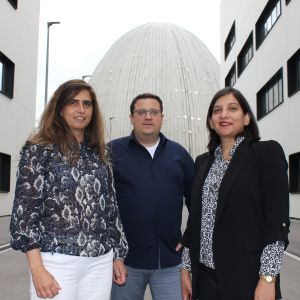
The new group: Joana Rebelo Kornmeier, Christian Stieghorst, Neelima Paul (from left to right) © MLZ
Getting beamtime at MLZ and performing experiments for the first time is an exhilarating experience. For some new users, however, data analysis of acquired data is quite challenging. To avoid situations where valuable data is left untreated due to lack of experience and adequate support, MLZ creates a new group for user support, which will work in close cooperation with the instrument scientists.
The data evaluation group led by Neelima Paul is a team of scientists, who have several years of technical and scientific work experience at selected neutron and X-ray instruments at the MLZ and in using various software packages for evaluation of the obtained neutron and X-ray data. The goal of this newly established group is to offer guidance and active support to the user community, particularly to new users, in both data evaluation and reduction steps, and to assist them in obtaining meaningful insights from obtained data by offering also writing support for preparing a publication.
Neelima Paul (FRM II)
First group of GNeuS fellows are on the way!
The GNeuS COFUND fellowship programme has recently communicated the final results of its first call for fellows.
The first step was the submission of the applications that closed on Jan 15th: a total of thirty applications were timely submitted on the GNeuS online system developed for the project. Then the selection process was carried out by the GNeuS Selection Panel (38 experts), supported by the GNeuS Management Office (Flavio Carsughi and Mayada Abdelgalil) and by the HR representatives of the three MLZ partners involved in the GNeuS project, namely Forschungszentrum Jülich, Technische Universität München and Hereon.
The 13 weeks process allowed them to select 15 excellent candidates, who will start their contracts in the coming months. They are mainly coming from Asia (9 over 15) and will work on Condensed Matter and Materials and Neutron Sources and Methods and Instruments, Accelerators and Detectors oriented projects. Notably, the gender balance is well respected with seven female researchers selected.
Flavio Carsughi (JCNS)
Interested?
The GNeuS Call N. 2 will open on 01/11/22, with a closing date on Jan. 18th, 2023.
Further information on https://www.gneus.eu/
Newly Arrived
Mayada Abdelgalil
I have joined as a PM assistant in the GNeuS project. A bit earlier, I worked in corporate development at Forschungszentrum Jülich GmbH.
I have a Ph.D. in Microbiology, but I found my passion in Science Management. After my promotion, I worked as a postdoc for two years, but then I switched my carrier to science management where I received training in project management and obtained the IPMA (International Project Management Association) – level D.
I’m looking forward to furthering challenges and cooperation in the GNeuS project!
Users
» European neutron community sticks together» First round of deuteration proposals
» Remarks of the MLZ User Committee
European neutron community sticks together
At the moment, there are no neutrons at the MLZ – and all over Europe, it is difficult to get beam time at a neutron source due to further shutdowns and maintenance breaks. The European research community is therefore ready to help: The Budapest Neutron Center (BNC) offered access within the scope of the League of advanced European Neutron Sources (LENS).
MLZ goes BNC
Proposals that had already been accepted at other facilities but could not be conducted due to the circumstances could be submitted to the BNC. At MLZ, the instrument teams checked the available proposals carefully (e.g. the research reactor at Budapest delivers only 10 MW compared to FRM II’s 20 MW) and then went through the process together with the interested users.
After feasibility discussions with the respective instrument scientists in Budapest, twelve proposals from MLZ users were accepted: They came from ANTARES, KWS-1, KWS-2, NAA, PGAA, and MIRA. First experiments have already been conducted – partly remotely but also on-site. The users were accompanied by the MLZ local contact to assist them during beam time.
This was a great possibility to show the advantages of LENS!
First round of deuteration proposals
A total of 16 proposals had been submitted before the deadline of the first proposal round for the newly established JCNS Deuteration Service. While most of the main proposers are working at German and other European facilities, two proposals were handed in from users based in the USA. This shows the interest in deuterated materials worldwide.
Among the compounds requested, temperature-responsive polymers were especially needed. The variety went far beyond the well-known PNIPAM. For this reason, we started to build up a platform, which will allow accessing efficiently a significant number of such monomers/polymers. Besides this, there was a strong need for other polymers and also for surfactants. As there was close contact between the users and the synthesis team in the proposal submission phase, it will be possible to realize most of the requests and thus, 15 of the submitted 16 were accepted.
Jürgen Allgaier, Ina Lommatzsch (JCNS)
Remarks of the MLZ User Committee
After over two years of harsh Covid-19 restrictions, most of us are back to normal scientific activities in terms of lab work at home and large-scale facilities as well as attending scientific conferences, albeit we need to adjust to the new normal. We all have to make an extra effort to make up for lost time and to restore the working environment that we were used to before the pandemic.
Problems to get neutrons
However, as we plan for new neutron experiments, we can note that only ISIS and PSI in Europe are operating now. In addition, NIST, frequently used by European scientists is not up and running yet. Although in a couple of years ESS will be up and running, there will be a shortage of neutron beam time. In particular, if we consider the expected increase of users in the industrial sector as well as in life science and soft matter.
Here, the neutron community is very proactive, which was apparent IMoH 2022 – Meeting on Opportunities and Challenges for Hicans in Bilbao, June 21st-22nd 2022. The meeting was dedicated to the case for high-intensity compact accelerator-driven neutron sources (HICANS) that will make access to neutrons easier than today’s sources. Very concrete plans, which in some cases already have been started to be realized, were presented and discussed.
Meet the MLZ User Committee!
I would also like to remind you about the ESS and ILL User Meeting in Lund on Oct. 5th-7th, where you will get the chance to experience the progress of the ESS project. ICNS 2022 will be in Buenos Aires on Aug. 21st-24th. I hope we can meet in person at any of these events. Some of you might be interested in the XVIII. International Small-Angle Scattering Conference (SAS2022) in Campinas/ Brasil on Sept. 11th-16th.
Unfortunately, we still cannot see an end to the tragic war in Ukraine. So much suffering for innocent people close to us! Our thoughts go to the families of the many innocent victims of the war.
On the behalf of the MLZ User Committee.
Tommy Nylander (Lund University)
Welcome to the MLZ Newsletter!
The MLZ Newsletter is sent directly to your inbox. All our users are invited to subscribe to it via GhOST!
You aren’t a scientific user but interested? Then just send an email to the MLZ User Office!
MLZ is a cooperation between:
 > Technische Universität München
> Technische Universität München > Helmholtz-Zentrum Hereon
> Helmholtz-Zentrum Hereon
 > Forschungszentrum Jülich
> Forschungszentrum Jülich
MLZ is a member of:
 > LENS
> LENS > ERF-AISBL
> ERF-AISBL
MLZ on social media:



